Abstract
We examined the relationship between cutaneous malignant melanoma/dysplastic nevi (CMM/DN) and chromosome 9p in 13 pedigrees with two or more living cases of invasive melanoma. We used two highly informative (CA)n repeats, D9S126 and IFNA, previously implicated in familial malignant melanoma (MLM), to conduct linkage analysis. Three analyses were performed: (1) CMM alone--all individuals without either confirmed melanoma or borderline lesions were considered unaffected (model A); (2) CMM/DN with both variable age at onset and sporadics (model B); and (3) CMM affecteds only--all individuals either without confirmed melanoma or with borderline lesions were designated "unknown" (model C). There was significant evidence for linkage to IFNA in all three models. For CMM alone, the maximum lod score (Zmax) was 4.36 at theta = .10 for model A and 3.39 at theta = .10 for model C. For CMM/DN (model B), Zmax = 3.05 at theta = .20. There was no significant evidence for linkage between CMM alone or CMM/DN and chromosome 9p marker D9S126. In addition, there was significant evidence for heterogeneity when a homogeneity test allowing for linkage to chromosome 9p or chromosome 1p or neither region was used. These results suggest that there is an MLM susceptibility locus on chromosome 9p but that familial melanoma is heterogeneous and not all families with CMM/DN are linked to a locus in this region.
Full text
PDF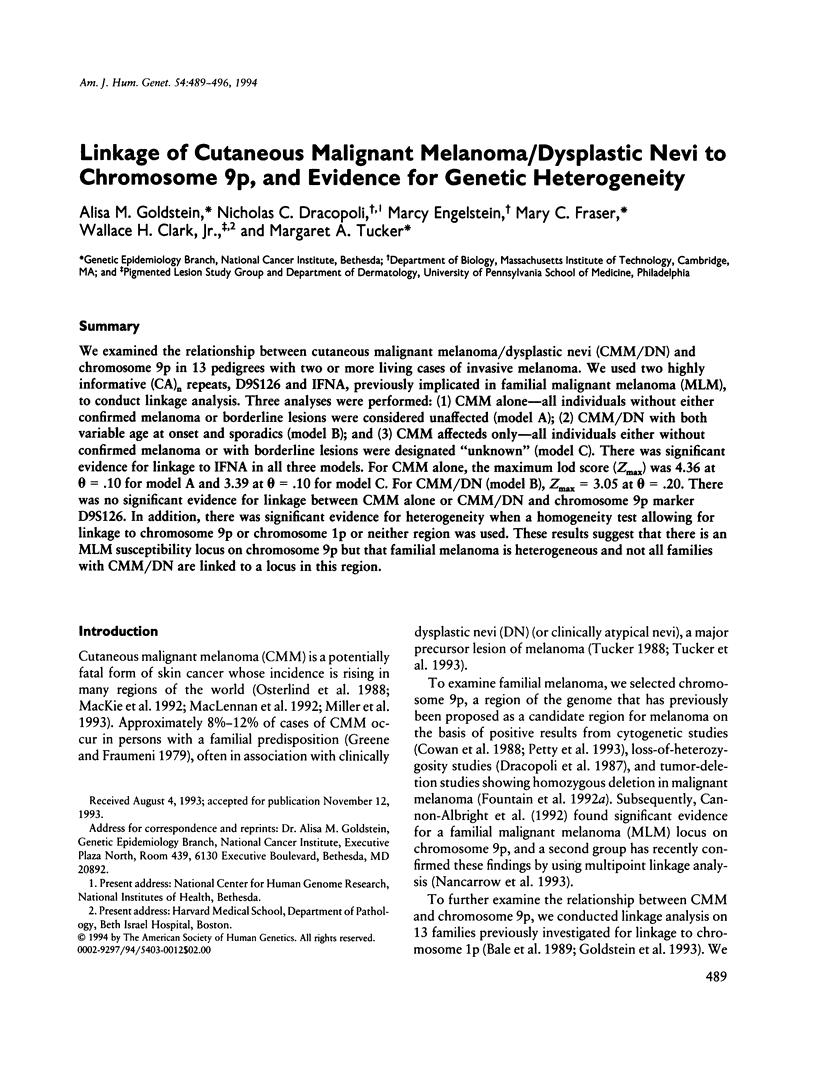
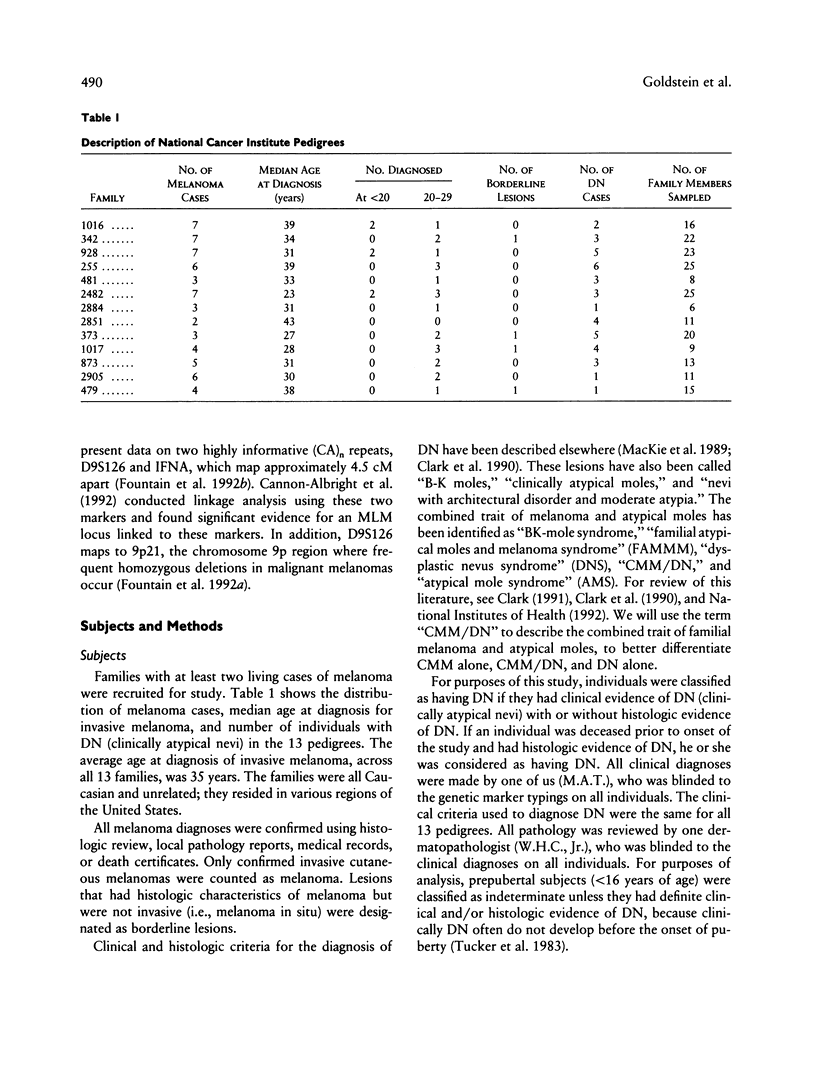
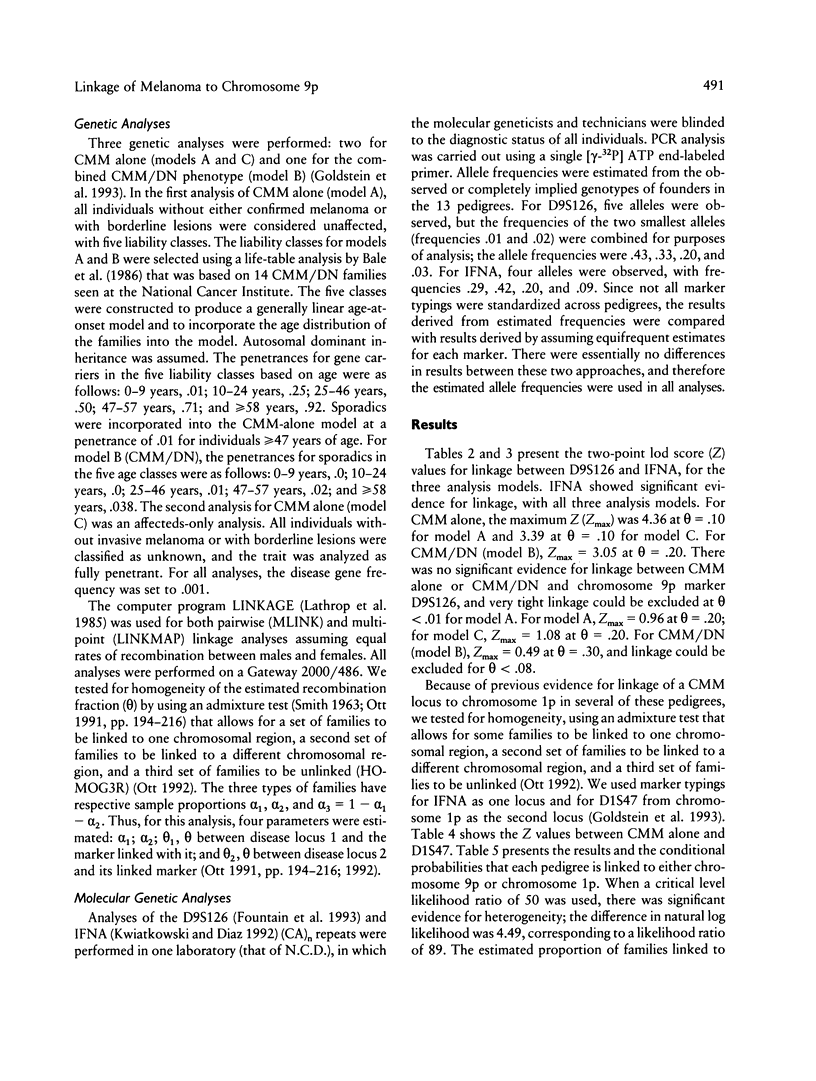

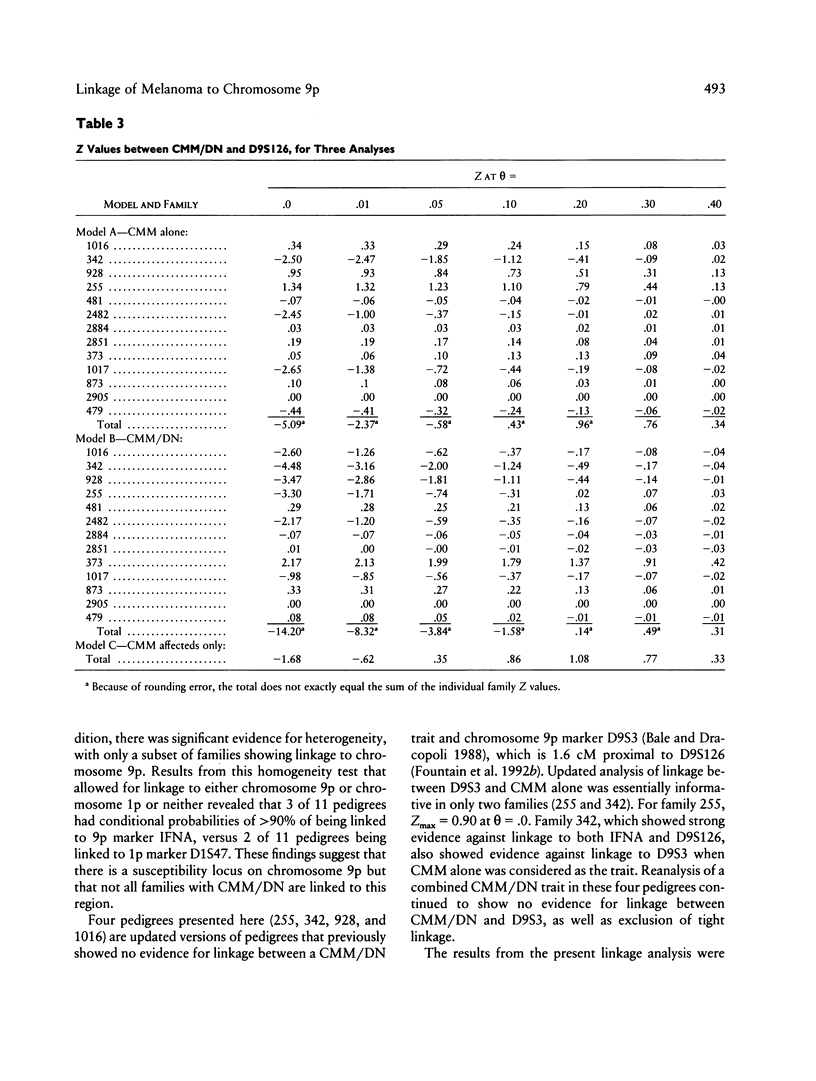
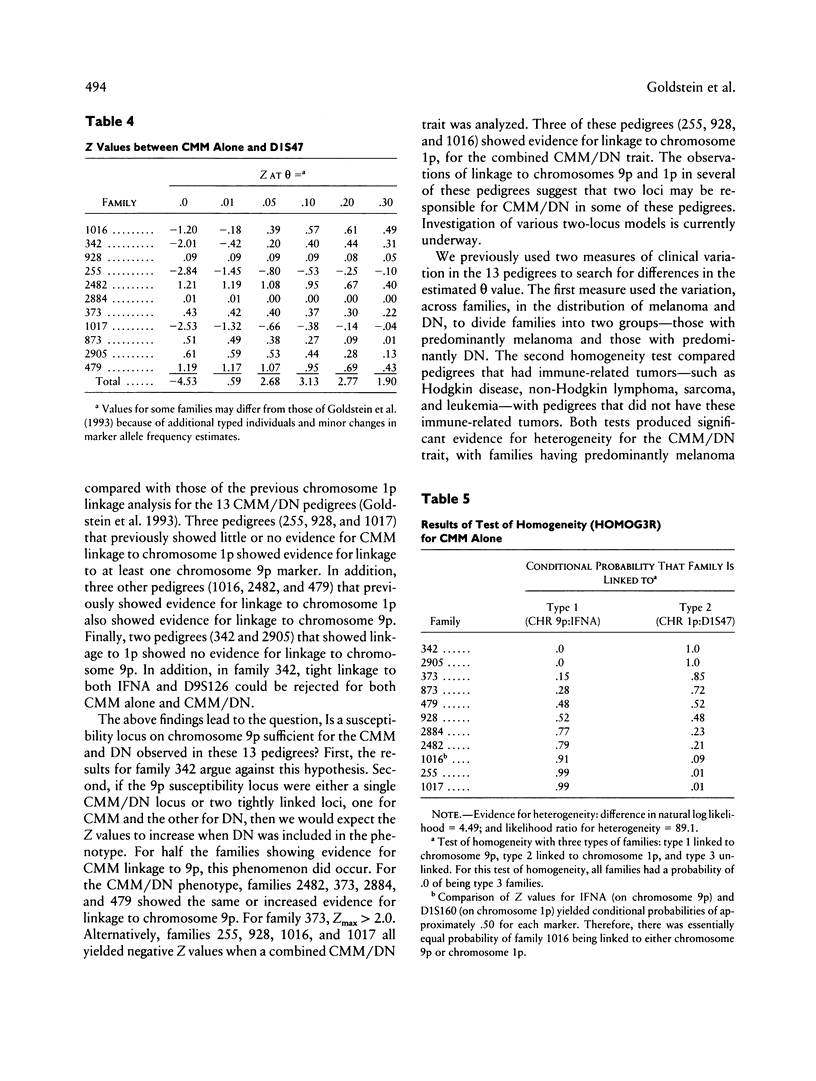
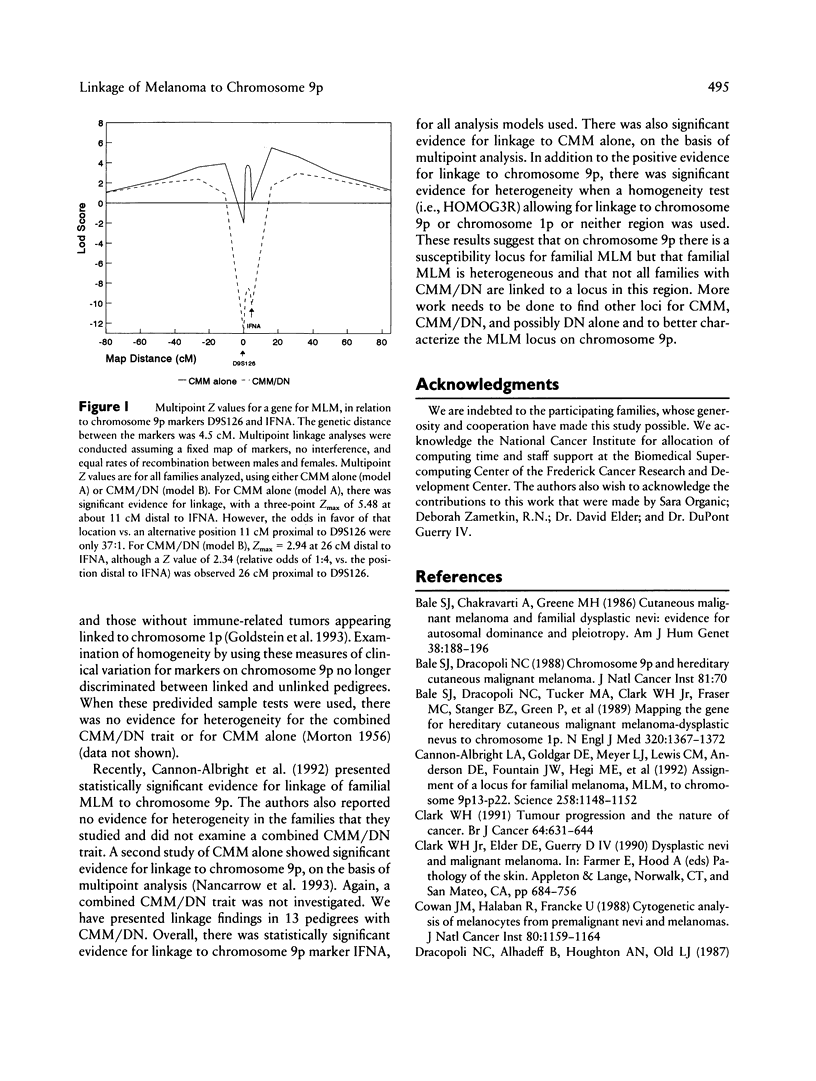
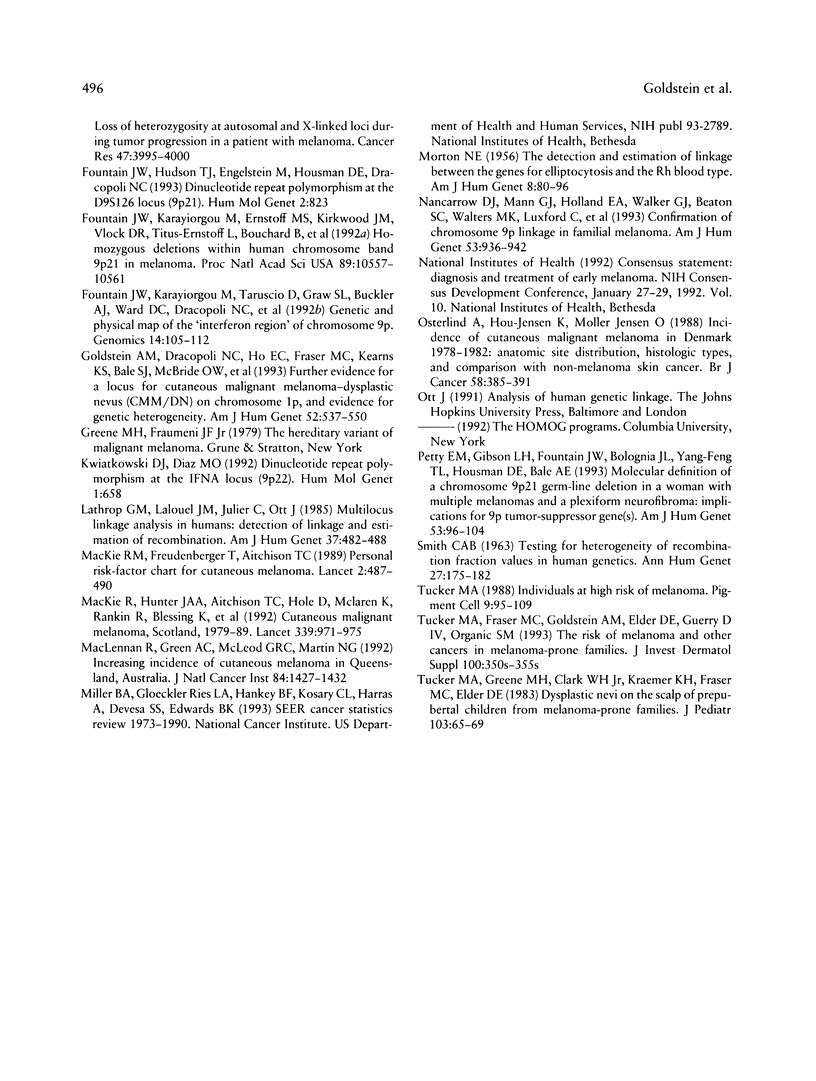
Selected References
These references are in PubMed. This may not be the complete list of references from this article.
- Bale S. J., Chakravarti A., Greene M. H. Cutaneous malignant melanoma and familial dysplastic nevi: evidence for autosomal dominance and pleiotropy. Am J Hum Genet. 1986 Feb;38(2):188–196. [PMC free article] [PubMed] [Google Scholar]
- Bale S. J., Dracopoli N. C. Chromosome 9p and hereditary cutaneous malignant melanoma. J Natl Cancer Inst. 1989 Jan 4;81(1):70–70. doi: 10.1093/jnci/81.1.70. [DOI] [PubMed] [Google Scholar]
- Bale S. J., Dracopoli N. C., Tucker M. A., Clark W. H., Jr, Fraser M. C., Stanger B. Z., Green P., Donis-Keller H., Housman D. E., Greene M. H. Mapping the gene for hereditary cutaneous malignant melanoma-dysplastic nevus to chromosome 1p. N Engl J Med. 1989 May 25;320(21):1367–1372. doi: 10.1056/NEJM198905253202102. [DOI] [PubMed] [Google Scholar]
- Cannon-Albright L. A., Goldgar D. E., Meyer L. J., Lewis C. M., Anderson D. E., Fountain J. W., Hegi M. E., Wiseman R. W., Petty E. M., Bale A. E. Assignment of a locus for familial melanoma, MLM, to chromosome 9p13-p22. Science. 1992 Nov 13;258(5085):1148–1152. doi: 10.1126/science.1439824. [DOI] [PubMed] [Google Scholar]
- Clark W. H. Tumour progression and the nature of cancer. Br J Cancer. 1991 Oct;64(4):631–644. doi: 10.1038/bjc.1991.375. [DOI] [PMC free article] [PubMed] [Google Scholar]
- Cowan J. M., Halaban R., Francke U. Cytogenetic analysis of melanocytes from premalignant nevi and melanomas. J Natl Cancer Inst. 1988 Sep 21;80(14):1159–1164. doi: 10.1093/jnci/80.14.1159. [DOI] [PubMed] [Google Scholar]
- Dracopoli N. C., Alhadeff B., Houghton A. N., Old L. J. Loss of heterozygosity at autosomal and X-linked loci during tumor progression in a patient with melanoma. Cancer Res. 1987 Aug 1;47(15):3995–4000. [PubMed] [Google Scholar]
- Fountain J. W., Hudson T. J., Engelstein M., Housman D. E., Dracopoli N. C. Dinucleotide repeat polymorphism at the D9S126 locus (9p21). Hum Mol Genet. 1993 Jun;2(6):823–823. doi: 10.1093/hmg/2.6.823-a. [DOI] [PubMed] [Google Scholar]
- Fountain J. W., Karayiorgou M., Ernstoff M. S., Kirkwood J. M., Vlock D. R., Titus-Ernstoff L., Bouchard B., Vijayasaradhi S., Houghton A. N., Lahti J. Homozygous deletions within human chromosome band 9p21 in melanoma. Proc Natl Acad Sci U S A. 1992 Nov 1;89(21):10557–10561. doi: 10.1073/pnas.89.21.10557. [DOI] [PMC free article] [PubMed] [Google Scholar]
- Fountain J. W., Karayiorgou M., Taruscio D., Graw S. L., Buckler A. J., Ward D. C., Dracopoli N. C., Housman D. E. Genetic and physical map of the interferon region on chromosome 9p. Genomics. 1992 Sep;14(1):105–112. doi: 10.1016/s0888-7543(05)80290-3. [DOI] [PubMed] [Google Scholar]
- Goldstein A. M., Dracopoli N. C., Ho E. C., Fraser M. C., Kearns K. S., Bale S. J., McBride O. W., Clark W. H., Jr, Tucker M. A. Further evidence for a locus for cutaneous malignant melanoma-dysplastic nevus (CMM/DN) on chromosome 1p, and evidence for genetic heterogeneity. Am J Hum Genet. 1993 Mar;52(3):537–550. [PMC free article] [PubMed] [Google Scholar]
- Kwiatkowski D. J., Diaz M. O. Dinucleotide repeat polymorphism at the IFNA locus (9p22). Hum Mol Genet. 1992 Nov;1(8):658–658. doi: 10.1093/hmg/1.8.658-a. [DOI] [PubMed] [Google Scholar]
- Lathrop G. M., Lalouel J. M., Julier C., Ott J. Multilocus linkage analysis in humans: detection of linkage and estimation of recombination. Am J Hum Genet. 1985 May;37(3):482–498. [PMC free article] [PubMed] [Google Scholar]
- MORTON N. E. The detection and estimation of linkage between the genes for elliptocytosis and the Rh blood type. Am J Hum Genet. 1956 Jun;8(2):80–96. [PMC free article] [PubMed] [Google Scholar]
- MacKie R. M., Freudenberger T., Aitchison T. C. Personal risk-factor chart for cutaneous melanoma. Lancet. 1989 Aug 26;2(8661):487–490. doi: 10.1016/s0140-6736(89)92097-7. [DOI] [PubMed] [Google Scholar]
- MacKie R., Hunter J. A., Aitchison T. C., Hole D., Mclaren K., Rankin R., Blessing K., Evans A. T., Hutcheon A. W., Jones D. H. Cutaneous malignant melanoma, Scotland, 1979-89. The Scottish Melanoma Group. Lancet. 1992 Apr 18;339(8799):971–975. doi: 10.1016/0140-6736(92)91539-k. [DOI] [PubMed] [Google Scholar]
- MacLennan R., Green A. C., McLeod G. R., Martin N. G. Increasing incidence of cutaneous melanoma in Queensland, Australia. J Natl Cancer Inst. 1992 Sep 16;84(18):1427–1432. doi: 10.1093/jnci/84.18.1427. [DOI] [PubMed] [Google Scholar]
- Nancarrow D. J., Mann G. J., Holland E. A., Walker G. J., Beaton S. C., Walters M. K., Luxford C., Palmer J. M., Donald J. A., Weber J. L. Confirmation of chromosome 9p linkage in familial melanoma. Am J Hum Genet. 1993 Oct;53(4):936–942. [PMC free article] [PubMed] [Google Scholar]
- Osterlind A., Hou-Jensen K., Møller Jensen O. Incidence of cutaneous malignant melanoma in Denmark 1978-1982. Anatomic site distribution, histologic types, and comparison with non-melanoma skin cancer. Br J Cancer. 1988 Sep;58(3):385–391. doi: 10.1038/bjc.1988.225. [DOI] [PMC free article] [PubMed] [Google Scholar]
- Petty E. M., Gibson L. H., Fountain J. W., Bolognia J. L., Yang-Feng T. L., Housman D. E., Bale A. E. Molecular definition of a chromosome 9p21 germ-line deletion in a woman with multiple melanomas and a plexiform neurofibroma: implications for 9p tumor-suppressor gene(s). Am J Hum Genet. 1993 Jul;53(1):96–104. [PMC free article] [PubMed] [Google Scholar]
- SMITH C. A. TESTING FOR HETEROGENEITY OF RECOMBINATION FRACTION VALUES IN HUMAN GENETICS. Ann Hum Genet. 1963 Nov;27:175–182. doi: 10.1111/j.1469-1809.1963.tb00210.x. [DOI] [PubMed] [Google Scholar]
- Tucker M. A., Fraser M. C., Goldstein A. M., Elder D. E., Guerry D., 4th, Organic S. M. Risk of melanoma and other cancers in melanoma-prone families. J Invest Dermatol. 1993 Mar;100(3):350S–355S. doi: 10.1111/1523-1747.ep12470264. [DOI] [PubMed] [Google Scholar]
- Tucker M. A., Greene M. H., Clark W. H., Jr, Kraemer K. H., Fraser M. C., Elder D. E. Dysplastic nevi on the scalp of prepubertal children from melanoma-prone families. J Pediatr. 1983 Jul;103(1):65–69. doi: 10.1016/s0022-3476(83)80777-x. [DOI] [PubMed] [Google Scholar]


